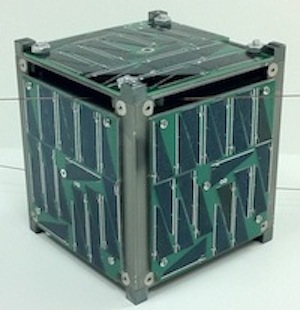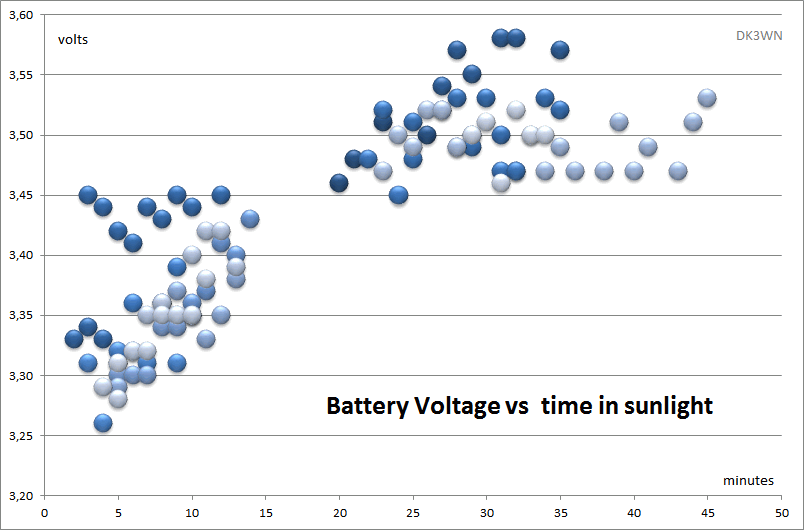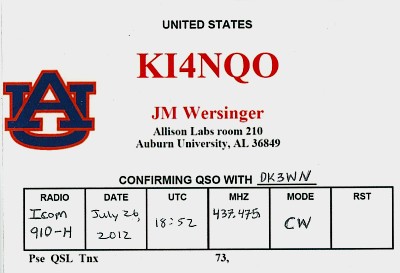Auburn University Alabama

Am 28. Oktober startete eine Delta II von Vandenberg um den Wettersatelliten NPP ins All zu bringen. Auf der Trägerstufe waren zudem 3 P-PODs montiert, die 6 Cubesats beinhalteten. Die Delta-II hob um 09:48 UTC ab und setzte genau eine Stunde später NPP in seinen Orbit.
Um 11:26 UTC öffnete sich der erste P-POD mit AubieSat-1, Explorer-1 Prime (E1P) und M-Cubed (in dieser Reihenfolge ausgestoßen).
NASA-Catalog: 37854
Downlink
437.473 MHz, CW
Audio
Call
KI4NQO
Status
seit Ende Dezember 2013 nicht mehr gehört
AubieSat-1 ist sehr leise. Wir gehen davon aus, dass sich die Antennen nicht entfaltet haben (Softwarefehler). Zudem ist er nur in den Eklipsen zu hören. Die Erklärung könnte ein thermisches Problem sein. Der Mikroprozessor regelt die Ausgangsleistung temperaturabhängig. Wenn der Satellit im Sonnenlicht ist, wird er einfach zu warm und die Ausgangsleistung wird fast bis auf 0 herunter geregelt. Wenn die Bake zu hören ist, ist sie sehr stabil. Das lässt auf eine gleichbleibende Temperatur schließen. Zudem ist auch die Spannung sehr stabil, die Lithium-Zellen sind auch nach 30 Tagen voll intakt.

CW Bake von AubieSat-1
Orbital Parameter
NORAD 37854 COSPAR designator 2011-061-E Inclination 101,711 RA of A. Node 318,300 Eccentricity 0,0254262 Argument of Perigee 122,401 Revs per day 14,78519377 Period 1h 37m 23s (97.38 min) Semi-major axis 7 012 km Perigee x Apogee 456 x 812 km BStar (drag term) 0,000283920 1/ER Mean anomaly 240,203
Telemetrie
Jede Minute wird eine Bake gesendet, die die Batteriespannung enthält, z.B. 4r23 = 4.23 Volt.
02:32 UTC hihi de aubiesat 1 vb 4r23 bacon 111 sk 02:33 UTC hihi de ki4nqo aubiesat 1 vb 4r22 sk 02:34 UTC hihi de ki4nqo aubiesat 1 vb 4r22 sk 02:35 UTC hihi de aubiesat 1 vb 4r22 bacon 111 sk 02:36 UTC hihi de ki4nqo aubiesat 1 vb 4r21 sk 02:37 UTC hihi de aubiesat 1 vb 4r21 bacon 111 sk 02:38 UTC hihi de ki4nqo aubiesat 1 vb 4r21 sk 02:39 UTC hihi de ki4nqo aubiesat 1 vb 4r21 sk
CW Baken am 18.12.2011
News
03. July 2012 It really looks like we reach an asymptote at about 3.5V. I believe it is the batteries that can take no more charge that limits the process. But we also saw one datum that says that the solar panels are at less than half power from what they were at the beginning of operations. Again, although we got the satellite to switch to outreach at least twice it got back to basic beacon because of a reset in eclipse.J.M. Wersinger

analyzed the 18 passes of AS-1 to see the dependency of the battery voltage from the time of the satellite in sunlight. Due to bandwidth of the values I assume it’s really a question of the orientation of the satellite. The maximum voltage dropped under 3.6 volts (more than 4.5 volts at the beginning).
09. September 2012 These are the lowest voltages I ever saw from AS-1. But she’s still working – interesting 🙂 Time in full sunlight after eclipse was less than 1 minute.
19:59 UTC hihi de ki4nqo aubiesat 1 vb 2r97 sk 20:01 UTC hihi de ki4nqo aubiesat 1 vb 2r92 sk 20:02 UTC hihi de ki4nqo aubiesat 1 vb 3r15 sk 21:31 UTC hihi de ki4nqo aubiesat 1 vb 3r04 sk (in eclipse) 21:32 UTC hihi de ki4nqo aubiesat 1 vb 3r02 sk 21:33 UTC hihi de ki4nqo aubiesat 1 vb 3r00 sk 21:34 UTC hihi de ki4nqo aubiesat 1 vb 2r97 sk 21:35 UTC hihi de ki4nqo aubiesat 1 vb 2r94 sk
From the timing of your observations and the statement that the satellite is coming into full sunlight from eclipse, it does not look like the battery is holding up very well anymore. The voltage is rising over 150 millivolts in a period of three minutes, plus the voltage readings are not continuously increasing, which would indicate tumbling to me and operation from different solar panels. The commercial data sheet for the battery indicates a life of 500 cycles or so, and AS-1 has been through many more than that since last October. AS-1 is probably just running on power generated directly from the solar panels, and not much stored in the battery at this point. But, that is a guess at quite a distance just looking at the battery telemetry.
John, WB4LNM

QSL-Karte

A QSL verification of receipt card is now available for AubieSat-1 / AO-71 reception. Operators desiring a confirmation of receipt for AO-71 are invited to send their signal reports to:
Dr. J-M Wersinger, KI4YAU Allison Laboratories Room 210 Auburn University, AL 36849
Please note the date and time of receipt on your request (or your QSL card), as well as any other pertinent receiving information or conditions. Copies of the content of the CW signals you copied are requested, but not required.